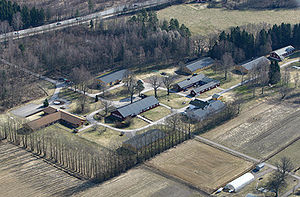
Berg concentration camp
Encyclopedia

Tønsberg
is a city and municipality in Vestfold county, southern Norway, located around north-east of Sandefjord. The administrative centre of the municipality is the city of Tønsberg....
in Norway
Norway
Norway , officially the Kingdom of Norway, is a Nordic unitary constitutional monarchy whose territory comprises the western portion of the Scandinavian Peninsula, Jan Mayen, and the Arctic archipelago of Svalbard and Bouvet Island. Norway has a total area of and a population of about 4.9 million...
that served as an internment and transit center for political prisoners and Jews during the Nazi occupation of Norway.
Establishment
The camp at Berg was founded upon an initiative in the fall of 1941 from Norwegian officials Nasjonal Samling and with some opposition from the German occupying authorities, Wilhelm RediessWilhelm Rediess
Wilhelm Rediess was the SS and Police Leader during the German occupation of Norway in the Second World War. He was also the commanding General of all SS troops stationed in occupied Norway, assuming command on 22 June 1940 until his death in 1945.- Early life :Rediess was born in Heinsberg,...
in particular. The main advocates for the camp were Minister of Justice Sverre Riisnæs
Sverre Riisnæs
Sverre Parelius Riisnæs was a Norwegian jurist and public prosecutor who was born 6 November 1897 in Vik, Sogn county and died 21 June 1988 in Oslo...
, mayor Bjerck of Tønsberg, and head of the Hird in Vestfold
Vestfold
is a county in Norway, bordering Buskerud and Telemark. The county administration is in Tønsberg.Vestfold is located west of the Oslofjord, as the name indicates. It includes many smaller, but well-known towns in Norway, such as Larvik, Sandefjord, Tønsberg and Horten. The river Numedalslågen runs...
, Eivind Wallestad. Police minister Jonas Lie
Jonas Lie (government minister)
Jonas Lie was a Norwegian councillor of state in the Nasjonal Samling government of Vidkun Quisling in 1940, then acting councillor of state 1940–1941, and Minister of Police between 1941 and 1945 in the new Quisling government...
approved the construction plans on June 12, 1942.
Vidkun Quisling
Vidkun Quisling
Vidkun Abraham Lauritz Jonssøn Quisling was a Norwegian politician. On 9 April 1940, with the German invasion of Norway in progress, he seized power in a Nazi-backed coup d'etat that garnered him international infamy. From 1942 to 1945 he served as Minister-President, working with the occupying...
had spoken of the camp at a speech in Horten
Horten
is a town and municipality in Vestfold county, Norway—located along the Oslofjord. The administrative centre of the municipality is the town of Horten. The municipality also includes the villages of Borre, Åsgårdstrand, Skoppum, and Nykirke....
on May 25, 1942 as an expression of his outrage of the Norwegian Constitution Day
Norwegian Constitution Day
Norwegian Constitution Day is the National Day of Norway and is an official national holiday observed on May 17 each year. Among Norwegians, the day is referred to simply as syttende mai or syttande mai , Nasjonaldagen or Grunnlovsdagen , although the latter is less frequent.- Historical...
celebration among Norwegian patriots. He promised his political opposition that a "chicken coop
Chicken coop
A chicken coop is a building where female chickens are kept. Inside there are often nest boxes for egg laying and perches on which the birds can sleep, although coops for meat birds seldom have either of these features....
" would be established for them.
The camp was planned to have a capacity of 3,000 prisoners but was never fully finished. It was unique among the camps in Norway in that it was run entirely by Norwegians under the authority of the Ministry of Police.
Prisoners
The first prisoners to Berg were a contingent of 60 male Jews that had been arrested on October 26, 1942. They arrived by train and were force-marched into the still-unfinished camp. The barracks were uninsulated, had no sanitary facilities, beds, or other furniture. Within two days there were 350 prisoners, under the administration of Leif Lindseth. They were told that anyone who tried to escape would be summarily shot; and that ten of their fellow inmates and their families would be shot in retribution.During the month before their deportation
Jewish deportees from Norway during World War II
During the Nazi occupation of Norway, German authorities deported about 768 individuals of Jewish background to concentration camps outside of Norway. 28 of these survived World War Two.-Deportation:The deportation schedule for the major transports was:...
, the Jewish prisoners were put to hard labor, expanding the camp. They worked seven days a week from 7:30 am to 8:30 pm, subsisting on a quarter loaf of bread, soup from flowers, and ersatz coffee.
The local Red Cross chapter, led by Anton Jervell, made attempts to provide relief to the prisoners with mixed success.
After most of the Jewish prisoners had been deported, several groups of political prisoners moved in. Conditions deteriorated after this, and disease became prevalent. In April 1943 conditions started to improve somewhat, but Berg was considered among the worst camps in Norway and far worse than Grini.
In addition to the 350 Jewish prisoners at Grini, 847 prisoners spent time at Berg. During the 1944/45 winter, the camp reached its maximum population of 500-600 prisoners. Of the 280 Jewish prisoners who were sent from Berg to camps in Germany, seven survived.
Famous prisoners include:
- Berthold EpsteinBerthold EpsteinBerthold Epstein was a Czechoslovakian pediatrician, professor, and scientist who worked as a doctor in the Auschwitz concentration camp during World War II.-Early life:...
- Victor Moritz Goldschmidt, 1942
- Herman Sachnowitz
- Ole ØisangOle ØisangOle Thorsen Øisang was a Norwegian newspaper editor and politician for the Labour Party.-Early life and career:...
, 1944–1945

